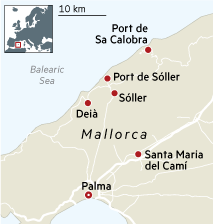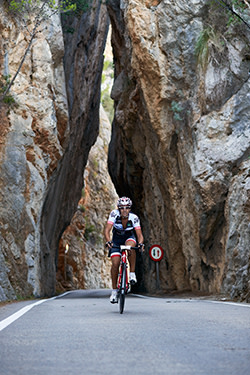Balearic bike heaven

Simply sign up to the Life & Arts myFT Digest -- delivered directly to your inbox.
At the top of Mallorca’s most famous climb, cyclists of a certain age lean on their bikes in various states of exhaustion. It’s spring in the Balearics and riders have migrated here in their thousands, mainly males from the colder grounds of Britain and Germany. There are big bellies and no bellies, smooth legs and hairy legs — and a gaudy array of Lycra plumages. Chirruping bike computers create a strange digital chorus.
As much as he is enjoying the novelty of blending in after a fraught two decades of racing, one man stands out from the crowds on Sa Calobra, a 10km cul-de-sac that winds up — and up — from the port of the same name on Mallorca’s north coast. While the rest of us rock in our saddles and grimace, David Millar has the unmistakable form of a pro — man and bike in flight as one beautiful machine.
Not that his heart has tipped much above resting rate today. The retired British bike racer, whom the French embraced in 2000 as “Le Dandy” during the first of his dozen Tours de France, is among the slowest climbers up Sa Calobra. He pedals at the more leisurely end of our small group, with neither bike computer nor a care for the time. Jon, our mechanic, trails a short distance behind in Millar’s Maserati, its V6 engine spluttering in protest against the low speeds.
I’ve come to Mallorca for three days to ride, eat and drink with Millar, who, as well as looking good on a bike, talks engagingly about his remarkable life on and off it, not least after the third bottle of rosé. My base is Jumeirah Port Sóller Hotel and Spa. Arranged in steps up a cliff above the cove of Port de Sóller, it offers a suitably chic yet relaxed setting for Millar’s own, not inexpensive, take on a burgeoning market within a market: the “ride with the pro” cycling holiday.
Millar considers his career in three chapters. It starts with Le Dandy, before the wheels came off in 2004 and he received a two-year ban for doping. Chapter two came with his return, where he became a contrite and powerful voice against the practice. Now he’s 39 and chapter three began just two years ago, when he was devastated not to make his team for the Tour de France. He retired shortly afterwards to his home in Girona, Spain, and had to work out what to do next.
He does TV, bringing measured insight to ITV’s Tour de France coverage in Britain. He wrote a memoir, Racing through the Dark, which charts his rise, ruin and rehabilitation. He does sponsorship work (the Maserati’s on loan) and he helped to design Chpt. III, his new line in luxury Lycra (that’s “chapter three” — you see what he’s done there). And now there’s this. Twice a year, in April and October, David can be yours for the weekend — and a price.

Mallorca was an obvious choice for his trips. For more than two decades, the Mediterranean island’s quiet roads, perfectly pitched climbs, and dozens of bike-friendly hotels have turned it into a magnet for bikes. This spring a record 140,000 cyclists were expected to roll through, significantly extending the island’s tourist season. And they have always followed in the tracks of pros. The scene here started modestly in the early 1990s, when Swiss track cyclist Max Hürzeler and the Irish Tour de France champion Stephen Roche began offering holidays. Current pros still flock here, and several teams locate their pre-season training camps among the Serra de Tramuntana, the mountain range that rears up along the north coast. Bradley Wiggins reportedly holds the unofficial record for the Sa Calobra climb, putting in a crazy time of 22-and-a-half minutes during a Team Sky camp on his way to Tour de France victory in 2012 (I pushed hard for a respectable 38:53).
The chance of a pro sighting adds to the allure of Mallorca. The island is firmly on the map of the serious amateur cyclist, who increasingly sets out to train like a pro, ride where the pros ride, and compare performances on Strava, the fitness app. Tenerife is another magnet, while the famous climbs of the Alps and Pyrenees host a growing calendar of gruelling, timed challenges. All of this ought to imbue Mallorca with a macho air. But while you can spot the riders going for good times on the climbs (guilty), the culture here is remarkably relaxed. At times it’s easy to imagine that they come not to cycle at all but rather to sit about sipping coffees, so resplendent with cycling jerseys are the village squares, where bikes rest against every wall and cycling shoes clop over cobbles.

It’s a culture that suits Millar’s third chapter, as he tells me on day two. Leaving Port de Sóller at a leisurely 9.30am, after breakfast on the Jumeirah’s Cap Roig terrace, we climb steadily to the south. Soon, we take a sharp left off the main road that leads to Palma up Coll de Sóller, a 5km climb through farmland and countless hairpins. Millar has been up it during the Challenge Mallorca, an annual professional race here. “I remember there used to be a bunch sprint up to this left turn, just so we could get ahead of the traffic before the hairpins,” he recalls. “My heart was at the limit before the climb even started.”
This time, we ease into the bends, riding side by side. Millar had said that there were no cafés at the top, but as we approach it’s clear there are two. “I just never noticed them,” he says, as we survey the view of the other side of the col, and the thrilling descent to come. “I never really looked around. For 18 years of racing I was looking down or in front, but now I can stop wherever and look at the view. I’ve spent the past couple of days looking at olive trees. I’ve never seen ones like these and I’m blown away by them.”

He’s right about the olive trees. Some are so thick they must be centuries old, wearing their bountiful stories in thick, gnarly layers. There are orange trees, too, and their scent sweetens the air on the slow tram ride from Port de Sóller to Sóller itself, a delightful cathedral town famous for its ensaïmadas, a Mallorcan pastry showered in icing sugar.
“Cycling is expeditionary,” Millar continues, as we chat on the col. “I want people to understand that you can just go for bike rides — you don’t have to just look forward to getting back to the hotel and uploading it to Strava.” The rider’s stealthy black bike reflects this approach, carrying no bike computer or logos. After wearing the hotel-sponsored kit for the photos taken on day one, he’s now back in his own gear, which is so understated it makes Rapha look like Moschino. “I spent my whole life covered in words and identities and now I quite like being invisible,” he says.
The feeling’s infectious. I push it on the climbs but am content otherwise to roll at a human pace. We still put in a decent 80km each day but there’s plenty of time to relax. In Santa Maria del Cami, a market town where we pause after our descent from Col de Sóller, we choose cakes at Celler Sa Sini, a restaurant now firmly on the map for cyclists. That afternoon, at the hotel’s infinity-pool bar, we feast on a giant paella before watching the end of the Amstel Gold Race, with Millar explaining the action.

But the biggest thrills come on the bike. I have cycled in mountainous parts of Europe only a handful of times and long climbs and descents remain a joyous novelty. On the last day, we take a right out of Sóller and head up and over the Carretera de Deià. During the descent, Millar offers a braking masterclass. As he approaches each hairpin, he shouts when he brakes and when, long before the end of the turn, he stops braking. Around more open bends he shouts, “No brake, no brake”, and it’s a slightly terrifying test of nerve to obey him.
We end up on the wooded coastline around Deià, a chichi town overrun in the summer with wealthy second-homers. Visitors who have lingered here include the English poet Robert Graves, who is buried in Deià, and Frédéric Chopin. It’s hard not to feel enriched by what Chopin described as “sea like lapis lazuli, mountains like emerald, air like heaven” — even while rattling along at 30km per hour. Just don’t forget to look up. “It’s nice to share this with people now,” Millar says of his new approach to cycling, as we come to another stop. “I never thought I’d enjoy it so much.”
Details
Simon Usborne was a guest of the Jumeirah Port Sóller Hotel and Spa and Sovereign. The next “David Millar Ultimate Cycling trip” runs October 20-24; prices start at £3,499pp, full-board, including flights from London, transfers, kit and a support vehicle
For more on our series on cycling adventures, see ft.com/greatrides
Photographs: George Marshall; Alamy
Letter in response to this article
Extreme commissioning by the FT’s Lycra wearers / From Simon Hall
Comments